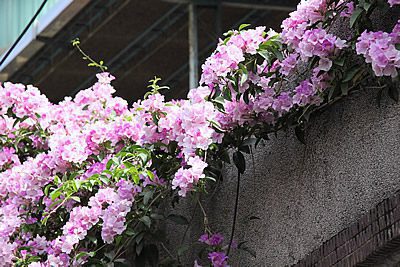The Glow Vine (Bignonia magnifica, formerly Saritaea magnifica) stands out as a flowering climber with a semi-woody, evergreen texture. It is native to Colombia and Ecuador in South America. Its structure is remarkably adapted for climbing, featuring scandent branches and cylindrical twigs marked with longitudinal streaks, which facilitate its support and ascent on vertical structures. The leaves of the glow vine consist of two opposite, oval leaflets, accompanied by two additional appendages at the stem insertion, and feature a tendril at the tip. This leaf arrangement is a distinctive characteristic of the species, allowing for its identification even in the absence of flowers.
The leaflets, in turn, exhibit a dark green hue, a leathery texture, and an attractive sheen, with well-defined venations, highlighting the beauty of this plant. The glow vine blooms throughout the year, but its flowering intensifies mainly in spring and summer. The flowers, with their trumpet shape and colors ranging from pink to lilac, have a yellowish-white, hairy center, a true natural masterpiece. It is interesting to note that the pollination of this plant is a spectacle in itself, carried out by bees of the genus Euglossa, known for their metallic coloration and solitary habits.
After the flowering phase, the glow vine develops a flat capsule-type fruit, which houses two winged seeds, an efficient mechanism for species dispersion by wind. In terms of cultivation, this climber is vigorous and fast-growing, making it an interesting choice to cover large supports, from fences to more elaborate structures like pergolas or arbors. In Brazil, its popularization is largely due to the renowned landscape architect Roberto Burle Marx, who used it in various projects, highlighting its beauty and versatility. Due to its highly floriferous nature, the glow vine has achieved great success in tropical regions, being widely cultivated in places like India and the southern United States for ornamental purposes.
The maintenance of the glow vine is relatively simple, requiring pruning to control its growth and biannual fertilizations to maintain its health and vigor. When it comes to its ideal cultivation conditions, it prefers full sun, in fertile, drainable soil, enriched with organic matter. In the first years after planting, supplementary irrigation is essential. However, once established, the plant shows remarkable resistance, needing watering only during drought periods.
Its tolerance to salinity is an advantage in coastal regions, but it’s important to highlight its susceptibility to intense cold or frosts. Conversely, it thrives in hot and humid climates. The propagation of the glow vine can be done through seeds, air layering, or cuttings, preferably in early spring, a conducive period for rooting and initial growth of the plant.

A vigorous and fast-growing climber, ideal for cultivation on large supports, from fences to pergolas or arbors. In Brazil, its popularity came mainly through the work of landscape architect Roberto Burle Marx. It is a highly floriferous species and has been very successful in tropical regions, being widely cultivated in India and the southern United States as an ornamental. It does not require much maintenance, which is limited to pruning to control its growth and biannual fertilizations.
It should always be cultivated under full sun, in fertile, drainable soil, enriched with organic matter, and irrigated in the first years after planting. Once well established, we can water only during drought periods. It tolerates the salinity of coastal regions. It is susceptible to intense cold or frosts. It thrives in a hot and humid climate. It can be propagated by seeds, air layering, or cuttings rooted in early spring.


